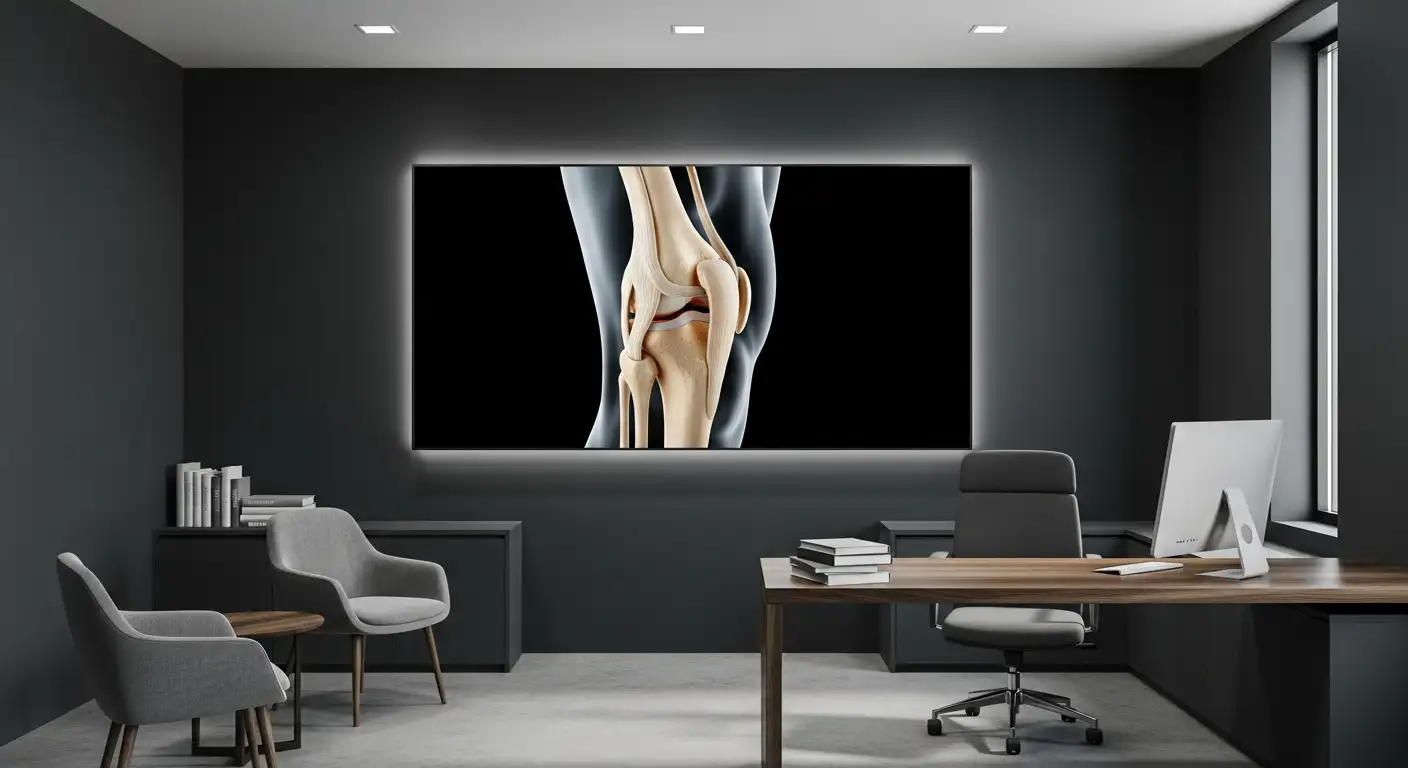Alleviating Inner Knee Pain During Bending
When it comes to knee pain, specifically inner knee pain experienced during bending, understanding the underlying causes and available treatment options is essential for finding relief. Let's explore the nature of inner knee pain and the treatment options that can help alleviate this discomfort.
Understanding Inner Knee Pain
Inner knee pain, often referred to as medial knee pain, is characterized by discomfort or pain on the inside of the knee joint. This type of pain can be caused by various factors, including overuse, injury, or underlying conditions such as osteoarthritis or ligament damage. The pain may worsen during activities that involve bending, twisting, or weight-bearing on the affected knee.

To determine the cause of inner knee pain, a healthcare provider may conduct a thorough examination, which may include physical tests, imaging scans, and medical history assessment. Proper diagnosis is crucial for determining the most appropriate treatment options.
Treatment Options for Inner Knee Pain
When it comes to managing inner knee pain during bending, several treatment options are available. One approach is to incorporate lifestyle modifications, such as rest, icing the affected area, and avoiding activities that exacerbate the pain. Physical therapy exercises can also help strengthen the knee muscles and improve flexibility, providing support and relief.
In cases where conservative measures are not sufficient, knee pain injections can be considered. These injections can provide targeted relief and help manage pain and inflammation. Let's explore some common knee pain injection options:
It is crucial to consult with a healthcare provider to determine the most suitable treatment option based on the underlying cause, severity, and individual factors. They can assess your specific condition and guide you towards the most appropriate course of treatment.
By exploring the available treatment options and working closely with a healthcare provider, individuals experiencing inner knee pain during bending can find relief and improve their overall quality of life.
Knee Pain Injection Options
When it comes to managing knee pain, there are several injection options available that can provide relief and improve function. Three common knee pain injection options are platelet-rich plasma (PRP) injections, hyaluronic acid injections, and corticosteroid injections.
Platelet-Rich Plasma (PRP) Injections
Platelet-rich plasma (PRP) injections have shown promising results in relieving knee pain and improving function, particularly in patients with osteoarthritis [1]. In this procedure, a sample of the patient's blood is processed to concentrate the platelets, which are rich in growth factors and other healing properties. The concentrated PRP is then injected into the knee joint.
PRP injections have been found to be safe and well-tolerated, with minimal side effects. Studies have shown that PRP injections can provide pain relief for up to six months [2]. However, it's important to note that the effectiveness of PRP injections may vary from person to person, and more research is needed to fully understand their long-term benefits.
Hyaluronic Acid Injections
Hyaluronic acid injections are another option for managing knee pain, especially in patients with mild to moderate osteoarthritis. Hyaluronic acid is a substance that occurs naturally in the joints and acts as a lubricant and shock absorber. In this procedure, hyaluronic acid is injected into the knee joint to provide relief from pain and improve mobility.
Hyaluronic acid injections can help lubricate the joint, reduce pain, and improve mobility in individuals with knee osteoarthritis. However, the effectiveness of hyaluronic acid injections may vary among individuals. It is important to note that these injections are typically considered after other treatments, such as pain relievers, have not provided satisfactory results [3].
Corticosteroid Injections
Corticosteroid injections can provide short-term relief from knee pain by reducing inflammation in the joint [4]. These injections contain a corticosteroid medication, which is a powerful anti-inflammatory agent. They are often used for conditions such as osteoarthritis, rheumatoid arthritis, and bursitis.
Corticosteroid injections can provide significant pain relief, but the effects are typically temporary and may wear off after a few weeks. It's important to note that repeated corticosteroid injections may have limitations and potential side effects, so they are usually administered judiciously under the guidance of a healthcare professional.
When considering knee pain injections, it's essential to consult with a healthcare provider who can evaluate your specific condition and recommend the most suitable treatment option. Factors such as individual variations in treatment response and the severity of the knee condition should be taken into account to ensure the best possible outcome.
Effectiveness of Knee Pain Injections
When it comes to addressing knee pain, injections can offer relief for individuals experiencing discomfort. Let's explore the effectiveness of three common knee pain injection options: platelet-rich plasma (PRP) injections, hyaluronic acid injections, and corticosteroid injections.
PRP Injections: Safety and Efficacy
Platelet-rich plasma (PRP) injections have shown promising results in relieving knee pain and improving function in patients with osteoarthritis. PRP is derived from the patient's own blood, which is processed to concentrate the platelets. These platelets contain growth factors that can potentially stimulate tissue regeneration and reduce inflammation.
PRP injections are considered safe and well-tolerated, with minimal side effects. However, it's important to note that individual responses to PRP injections can vary. Some individuals may experience significant pain relief and improved knee function, while others may not achieve the same level of benefit. Consultation with a healthcare provider is crucial to determine if PRP injections are suitable for your specific condition.
Hyaluronic Acid Injections: Benefits and Considerations
Hyaluronic acid injections are another option for managing knee pain, particularly in patients with mild to moderate osteoarthritis. Hyaluronic acid is a substance that occurs naturally in the joints, acting as a lubricant and shock absorber.
During the procedure, a healthcare professional administers the hyaluronic acid injection directly into the knee joint. Multiple injections may be needed, typically one week apart, for a total of three or four injections.
Hyaluronic acid injections can provide relief for knee pain by supplementing the natural hyaluronic acid in the joint. The treatment aims to improve joint mobility and reduce discomfort. However, it's important to note that the benefits of hyaluronic acid injections may vary among individuals. Some individuals experience significant pain relief and improved function, while others may have a more limited response.
Temporary pain or swelling in the knee joint may occur after receiving a hyaluronic acid injection, and if it persists or becomes worse, medical attention should be sought. Consulting with a healthcare provider is essential to determine if hyaluronic acid injections are a suitable treatment option for your specific knee condition.
Corticosteroid Injections: Short-Term Relief
Corticosteroid injections can provide short-term relief for knee pain, particularly in cases of inflammation and swelling. These injections deliver a powerful anti-inflammatory medication directly into the knee joint, reducing pain and improving mobility.
It's important to note that the effects of corticosteroid injections may wear off after a few weeks, and they are not considered a long-term solution for chronic knee pain [1]. These injections are often used as a temporary measure to alleviate symptoms, allowing individuals to engage in physical therapy or other rehabilitation exercises.
As with any medical treatment, corticosteroid injections come with potential risks and side effects. It's crucial to consult with a healthcare provider who can assess your specific knee condition and determine if corticosteroid injections are appropriate for you. They will consider factors such as the severity of your knee pain and any underlying conditions.
Knee pain injections can be a beneficial treatment option, providing relief and improving function for individuals experiencing knee discomfort. However, it's important to evaluate the effectiveness of each option in relation to your specific condition and consult with a healthcare provider to determine the most suitable course of treatment.
Factors to Consider for Knee Pain Injections
When considering knee pain injections as a treatment option, there are several factors that individuals should take into account. These factors can help determine the effectiveness of the injections and ensure that the treatment aligns with the individual's specific knee condition and needs.
Individual Variations in Treatment Response
It is important to recognize that the effectiveness of knee pain injections may vary from person to person. Each individual may have a unique response to the injections based on factors such as their overall health, the underlying cause of their knee pain, and their body's ability to heal. While knee injections can be a beneficial treatment option, it's crucial to manage expectations and understand that results may differ for each individual.
Severity of Knee Condition
The severity of the knee condition plays a significant role in determining the appropriateness of knee pain injections. Injections may be more effective for individuals with mild to moderate knee pain caused by conditions such as osteoarthritis or tendinitis [4]. However, for severe cases or injuries that require surgical intervention, knee pain injections may not be the primary course of treatment. Consulting with a healthcare provider is essential to assess the severity of the knee condition and determine the most suitable treatment plan.
Consultation with Healthcare Provider
Prior to undergoing knee pain injections, it is crucial to consult with a healthcare provider who specializes in knee pain management. A qualified healthcare provider can assess the individual's knee condition, review their medical history, and discuss the potential benefits and risks of the injections. They can provide personalized recommendations based on the individual's specific needs and help determine if knee pain injections are the right treatment option.
By considering individual variations in treatment response, the severity of the knee condition, and seeking guidance from a healthcare provider, individuals can make informed decisions regarding knee pain injections. It is important to remember that knee pain injections should be part of a comprehensive treatment plan that may also include physical therapy, lifestyle modifications, and other interventions tailored to the individual's needs.
Other Treatment Options
While platelet-rich plasma (PRP), hyaluronic acid (HA), and corticosteroid injections are commonly used for knee pain relief, there are other treatment options available for individuals seeking alternative approaches to alleviate their inner knee pain during bending. These options include stem cell injections, prolotherapy injections, and joint fluid therapy injections.
Stem Cell Injections
Stem cell injections are being studied as a potential treatment for knee pain caused by arthritis. This innovative approach involves injecting stem cells into the knee joint to stimulate tissue regeneration and reduce inflammation. The goal of stem cell therapy is to harness the regenerative properties of stem cells to promote the healing of damaged tissues in the knee. While research is ongoing, stem cell injections hold promise as a potential treatment option for individuals seeking long-term relief from inner knee pain.
Prolotherapy Injections
Prolotherapy is another treatment option that involves injecting a solution into the knee joint to stimulate the body's natural healing process. The solution typically contains substances such as dextrose, which are believed to promote tissue repair and reduce pain. Prolotherapy aims to strengthen the connective tissues in the knee, including ligaments and tendons, by inducing a controlled inflammatory response [2]. While prolotherapy may provide some pain relief, further research is needed to fully understand its effectiveness in treating inner knee pain.
Joint Fluid Therapy Injections
Joint fluid therapy injections, such as Synvisc, can be a beneficial option for individuals with knee osteoarthritis. These injections involve the injection of a gel-like substance into the knee joint to provide lubrication, reduce friction, and improve joint mobility. The injected fluid mimics the natural synovial fluid found in healthy joints, helping to alleviate pain and improve overall knee function [6]. Joint fluid therapy injections are particularly beneficial for individuals experiencing inner knee pain due to osteoarthritis.
It is important to note that the effectiveness of these alternative treatment options may vary from person to person. Factors such as the severity of the knee condition and individual variations in treatment response should be considered. It is recommended to consult with a healthcare provider who can assess your specific situation and provide guidance on the most appropriate treatment option for your inner knee pain during bending.
Knee Pain Injection Options
When it comes to alleviating inner knee pain during bending, there are several injection options available that can provide relief. These injections target the specific area of pain and can help reduce inflammation, improve function, and provide temporary pain relief. In this section, we will explore three common knee pain injection options: platelet-rich plasma (PRP) injections, hyaluronic acid injections, and corticosteroid injections.
Platelet-Rich Plasma (PRP) Injections
Platelet-rich plasma (PRP) injections have shown promising results in relieving knee pain and improving function, particularly in patients with osteoarthritis. PRP is a concentrated solution derived from the patient's own blood, which contains a higher concentration of platelets and growth factors. These components are thought to promote tissue healing and reduce inflammation.
The PRP injection procedure involves drawing blood from the patient, processing it to separate the platelets, and injecting the concentrated PRP directly into the knee joint. The growth factors in PRP may help stimulate tissue repair and reduce pain. However, the effectiveness of PRP injections may vary from person to person.
Hyaluronic Acid Injections
Hyaluronic acid injections are another option for managing knee pain, especially in patients with mild to moderate osteoarthritis. Hyaluronic acid is a naturally occurring substance in the body that helps lubricate and cushion the joints. In individuals with osteoarthritis, the hyaluronic acid in the knee joint may become depleted, leading to pain and discomfort.
Hyaluronic acid injections involve injecting a gel-like solution of hyaluronic acid directly into the knee joint. This injection helps to restore the natural lubrication and cushioning properties of the joint, reducing friction and relieving pain. It is important to note that hyaluronic acid injections are typically recommended for patients who have already tried other treatments without success.
Corticosteroid Injections
Corticosteroid injections provide short-term relief for knee pain by reducing inflammation in the joint. These injections contain a corticosteroid medication, which is a powerful anti-inflammatory agent. Corticosteroid injections can be beneficial for individuals experiencing acute knee pain or inflammation.
The procedure involves injecting the corticosteroid medication directly into the knee joint. The medication helps to reduce inflammation and alleviate pain. However, it's important to note that the effects of corticosteroid injections may wear off after a few weeks, and they are not a long-term solution for managing chronic knee pain.
When considering knee pain injections, it is essential to consult with a healthcare provider to determine the most suitable option for your specific needs. The effectiveness of these injections may vary depending on the individual and the severity of their knee condition. Your healthcare provider can assess your condition, discuss the potential benefits and risks of each injection option, and help guide you towards the most appropriate treatment for your inner knee pain during bending.
References
[2]:
[3]:
[4]:
[5]:
[6]:





